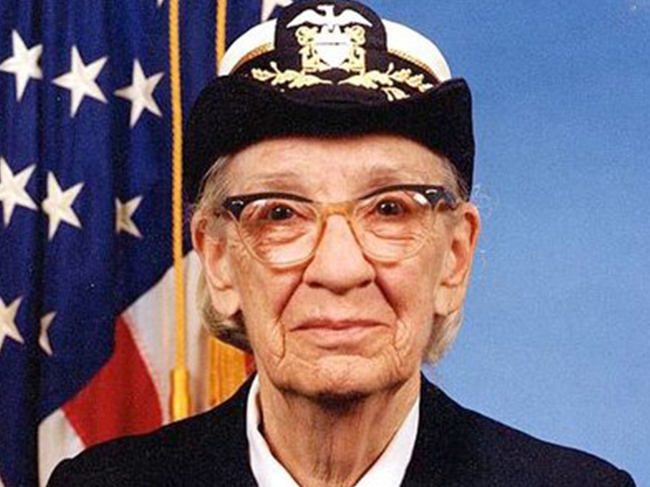Grace Hopper – First Lady of Software
Behind every successful person there lies some sort of story. It’s high time to celebrate United States Navy Admiral Grace Hopper achievements and remember her contribution done towards the world. It’s the birthday of the ‘First Lady of Software’.
Grace Hopper (December 9, 1906 – January 1, 1992) was known as the First Lady of Software. For being called the Software Lady, she did a lot of inventions since the age of 7. At the age of 7, when a normal child thinks of playing cricket and dolls, Hopper dismantled her alarm clock to figure out how it works. Such curious and analytical mind she had.
She was one of the first programmers in the history of computers. She helped develop a compiler that was a pioneer to the widely used COBOL (an acronym for Common Business-Oriented Language) language. It is just because of this Iron Lady’s influence that the programmers are using if/then” instead of 1s and 0s till today.
Her Life summarized in a paragraph:
Grace Hopper was born in New York City in 1906. In 1944, she joined U.S Navy during World War II and was assigned to program Mark I computer. Hopper served on the Mark I computer programming staff headed by Howard H. Aiken. Hopper and Aiken both coauthored three papers on the Mark I. It was also known as the Automatic Sequence Controlled Calculator. It’s believed that she resumed active naval service at the age of 60, becoming the navy rear admiral in 1986. In 1992, Hopper died in Virginia.
How was Hopper’s early life?
Born on December 9, 1906, Grace_Hopper studied Math and Physics at Vassar College. After graduating in 1928, she moved towards Yale University, and from same university Hopper received a Master’s degree in Mathematics in 1930. In 1930, Hopper married Vincent Foster Hopper, becoming Grace Hopper (a name that she kept back even after the couple’s divorce in 1945). While teaching at Vassar in 1931, Hopper continued to study at Yale, where she also earned her Ph.D. in Mathematics in 1934. She was one of the rare women to get such a high degree.
What was Hopper’s involvement in World War II?
Hopper, taught at Vassar as an Associate Professor until she joined back U.S. Naval Reserve in December 1943 during World War II. Hopper was commissioned as a lieutenant in June 1944. As her background was in Mathematics, the Bureau of Ordnance Computation Project at Harvard University was assigned to her. At Harvard, she learned to program a Mark I computer.
The Queen of the Computing Career
After the World War, Hopper served the Navy as a Reserve Officer. As she was a research fellow at Harvard, she got an opportunity to work with Mark II and Mark III computers. When Hopper was working with Harvard, a moth was found to have shorted Mark II. Since then, Hopper has been getting the credit for the invention of the term “computer bugs”. However, she was not the one to pen it down, but she somehow helped to popularize it.

Hopper moved into private industry in 1949, to continue working with computers. She has worked with Eckert-Mauchly Computer Corporation and Remington Rand. There, she supervised programming for the UNIVAC computer.
In 1952, her team generated the first compiler for computer languages. This compiler was a pioneer for the Common Business Oriented Language, accessible as COBOL, a widely adopted language used around the world. Hopper encouraged its adaptation although she didn’t invent it.
Awards and Achievements
In the course of her lifetime, Grace Hopper was given 40 honorary degrees from universities around the world, along with numerous awards and honors including:
• First person to win “Computer Science Man of the Year” award from the Data Processing Management Association in 1969,
• The first person from the United States and the first woman from any country to be made “Distinguished Fellow of the British Computer Society” in 1973,
• The first female to receive the “National Medal of Technology” as an individual in 1991.
Why did Hopper return to the Navy?
In 1966, Hopper retired from the Naval Reserve. Her pioneering computer work recalled to active duty. At the age of 60, she was remembered to tackle standardizing communication between different computer languages. For 19 years, she was there with the Navy. In 1986, when she retired from the services, she aged 79 and was a rear admiral. She too was the oldest serving officer at that time.
Hopper’s Later Years
Hopper took another job post-retirement and stayed in the computer industry for several more years. She died in Arlington, Virginia, on January 1, 1992. Hopper was 85 years old when she died and was laid to rest in the Arlington National Cemetery.
In 1997, USS Hopper (guided missile destroyer), was custom-made by the Navy in San Francisco. In 2004, the University of Missouri honored her with a computer museum on their campus, dubbed “Grace’s Place.”
What Hopper used to say (Her Legacy in her words):

The most important thing I’ve accomplished, other than building the compiler, is training young people. They come to me, you know, and say, ‘Do you think we can do this?’ I say, ‘Try it.’ And I back ’em up. They need that. I keep track of them as they get older and I stir ’em up at intervals, so they don’t forget to take chances.
Furthermore, on her birthday in 2013, Hopper was recalled with a “Google Doodle“ and in 2016; she was honored with the “Presidential Medal of Freedom” by US President Barack Obama.

